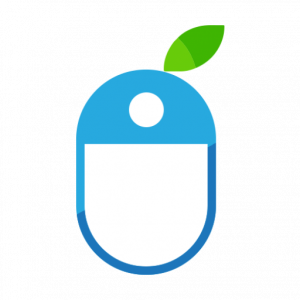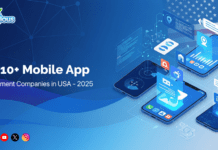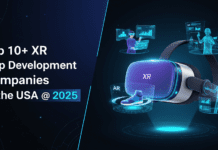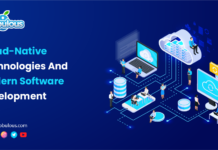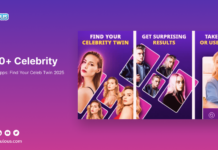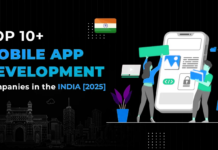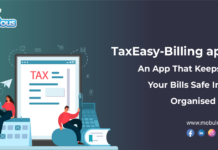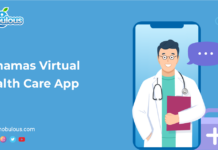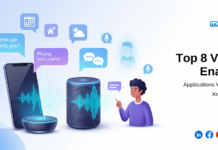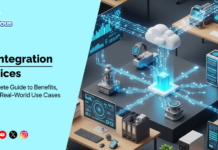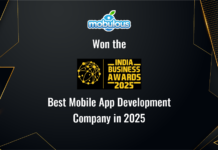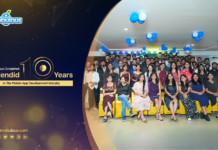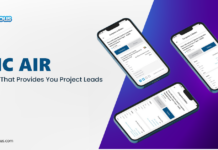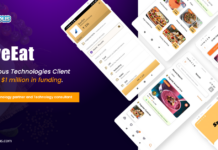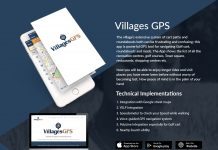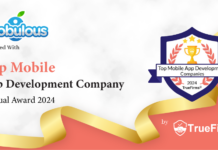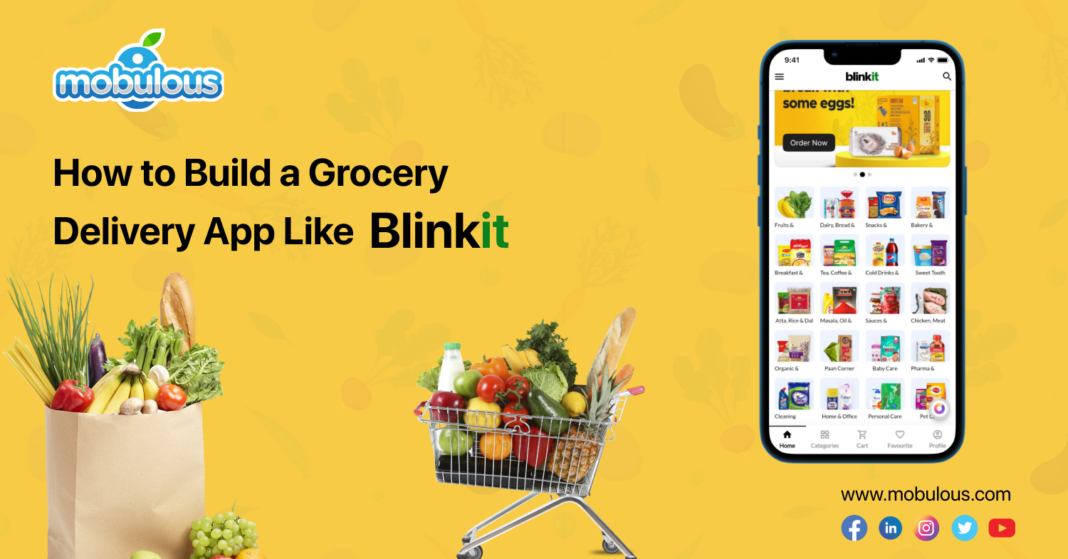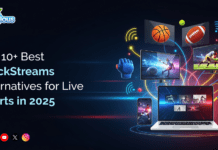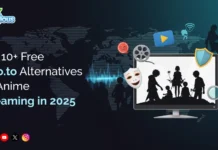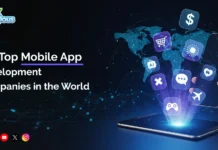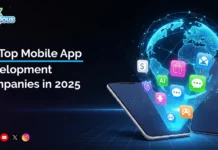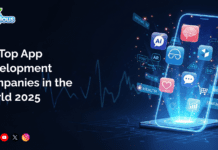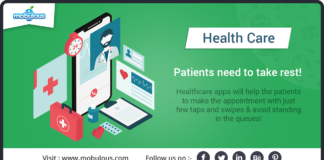Build a Grocery Delivery App Like Blinkit
Grocery delivery apps have simplified shopping, saving time and effort, providing convenience by delivering groceries right to our doorsteps and enriching security with contactless delivery possibilities. With the intro of Q-commerce or Quick commerce, firms like Blinkit swear instant grocery delivery within 10 minutes right at your doorstep.
Creating an app similar to Blinkit mandates careful planning, integration of numerous technologies, and familiarity with the market. We understand that creating a grocery store delivery app like Blinkit is a daunting job but with the right approach and strategy, it can become a seamless and hassle-free task.
Let’s learn all that you need to know concerning how to build a grocery ordering app perfectly, its features, how it works, and the cost of grocery shopping app development. So, without any further ado, let’s get activated!
What is a Grocery Delivery App?
A grocery shopping app is a mobile application that encourages users to order groceries online and deliver their ordered items right to their doorstep. These applications provide a suitable platform where users are able to browse a wide variety of products, pay digitally, and search multiple items.
They normally provide components like product search, precise descriptions, personalized suggestions, and user reviews. Once an order is placed, the mobile app corresponds with local grocery stores and delivery personnel in order to ensure delivery at the stipulated time.
Grocery delivery apps can boost your business by enriching convenience, saving time, and offering a contactless grocery shopping venture. This makes these apps exceptionally popular in today’s 21st century.
Understanding the Blinkit App?
Blinkit was formerly known as Grofers and is considered an on-demand grocery delivery app that permits users to order groceries and other important stuff online.
The app proposes a wide array of products such as pantry staples, fresh produce, personal care products, skincare products, and household items. The app aims to deliver orders quickly, usually within minutes, by partnering with local stores and utilizing a network of delivery personnel.
With user-friendly elements like easy search, real-time order tracking, and diverse payment alternatives, Blinkit provides an efficacious and suitable shopping experience that caters to the fast-paced lifestyle of metropolitan consumers.
Why Should You Create a Grocery Delivery App Like Blinkit?
Creating a grocery shopping app like Blinkit swabs into the evolving need for suitable online shopping. It ensures high customer retention via continuous use and averages advanced technologies for personalized experiences. This makes it a lucrative business possibility.
- Growing market demand: The favor of online grocery shopping is unwinding at an instantaneous pace, presenting a lucrative market prospect.
- Convenience: Grocery delivery apps proffer users the convenience of shopping from the comfort of their homes and saving time and effort.
- High Customer Retention: Consistent, frequent, and repeat purchases propel customer loyalty and consistent revenue.
- Technological Advancements: Utilize modern technology such as AI for personalized experiences and effective delivery.
- Competitive Edge: You will be able to stand out by offering users unique and exceptional features and superior customer services compared to conventional shopping.
- Revenue Model: Considerable monetization strategies and approaches such as delivery fees, advertising, and ad subscriptions, offer multifarious income streams.
How to Develop a Grocery Delivery App Like Blinkit?
Grocery delivery app development just like Blinkit implicates organized and strategic planning and technique, assimilating the most delinquent technology, and providing a user-centric understanding. Here are the important steps to develop a successful grocery store app development.
- Determine your grocery app development purpose.
- Select the app development platform.
- Select the essential features of an app like Blinkit.
- Choose the right technology stack.
- Design the UI/UX of the app.
- Start developing the front end of the app.
- Backend development of the app.
- Testing and Quality Assurance.
- Launch the app on the App Stores.
1. Determine Your Grocery App Development Purpose
The first stage is to specify the objective of your app. Make sure to get a solution to your question whether you are seeking to provide a faster delivery service, excellent customer service, or an expansive assortment of products.
Understand your core objectives as it will assist you in shaping the features and user experience of your grocery delivery app like Blinkit. Conduct thorough market research and demonstrate what unique value your delivery app is able to provide in order to attract, engage, and retain users.
Also Read:- Trend Prediction & Challenges of Grocery Delivery App!
2. Select the App Development Platform
Selecting the right platform for your application is important. You are able to choose a single platform either iOS or Android or pick a cross-platform approach. Make sure to assess the priorities, timeline, and funding of your target audience when making this judgment.
Nevertheless, cross-platform development frameworks such as Flutter and React Native can assist you a lot in saving time and resources by facilitating you to create grocery delivery apps for both platforms simultaneously.
Also Read:- How Choosing Flutter Makes Your Project Cost Efficient?
3. Select the Essential Features of an App Like Blinkit
Selecting the crucial features is mandatory for building an app like Blinkit. These essential features include user registration and login, multiple payment gateway interactions, seamless shopping cart and checkout updates, effective customer support, etc.
These features ensure a seamless, smooth, and user-centric experience that improves customer retention, engagement, and satisfaction.
4. Choose the Right Technology Stack
Selecting the appropriate technology stack is essential for the performance and scalability of your app. Here is a recommended technology stack and framework for building a grocery delivery app like Blinkit.
- For Frontend: Leverage React Native or Flutter.
- For Backend: Use Node.js or Django.
- For Database: Use MongoDB or PostgreSQL.
- Enclose third-party integrations, including payment gateways, geolocation services, and notification services in your grocery ordering app.
Also Read:- What is the Importance of Java Programming Language in 2024?
5. Design the UI/UX of the App
User Interface and User Experience, i.e., UI and UX designs are essential for the victory of your application. A perfectly designed app entices and enthralls users by providing a seamless and visually attractive experience.
A good UI/UX design enhances user satisfaction, increases engagement, and ends bounce rates. It guarantees that your users are able to guide the grocery delivery app effortlessly and complete all the assignments efficiently.
Here are the most promising techniques and practices in UI/UX design:
- Simplicity: Make sure to keep the design straightforward and clean.
- Intuitive Navigation: Make sure that users are able to discover what they want without any chaos.
- Consistency: Leverage consistent design components and interactions.
- Accessibility: Design for all users, including those with disability.
- Feedback: Makes sure to provide quick feedback for user actions such as confirmation messages, loading indicators, etc.
6. Start Developing the Frontend of the App
Start with the front-end development of your grocery delivery app, concentrating on creating a user-centric and responsive user interface.
Leverage the selected frontend framework, including React Native or Flutter in order to develop the layout, features, and navigation.
Make sure that the design of your app like Blinkit is consistent and uncluttered across multiple devices and different screen sizes.
7. Backend Development of the App
Now, start developing the backend of the app in order to handle and manage the app’s server-side logic, and integrations with third-party services. Hire a backend developer who can help you build a top-notch grocery delivery app that drives business growth to extended heights.
Set up the required APIs in order to connect the front end and the back end. Ensure that the back end is secure and scalable and is capable of managing high traffic and safeguarding user data and other crucial information.
Below are the crucial steps for backend development. Make sure to read them thoroughly:
- Setup Server Environment: Select a reliable server hosting service.
- Database Design: Design a database schema in order to handle and manage user data, product listings, orders, and several others.
- API Development: Build RESTful APIs in order to manage data exchange between the front end and the back end.
- Integration: Incorporate third-party services, including geolocation APIs and payment gateways.
- Security: Enforce security measures and benchmarks in order to safeguard user data and transactions.
8. Testing and Quality Assurance
Testing and Quality Assurance are important phases in grocery delivery app development like Blinkit in order to ensure performance, functionality, and user satisfaction. It incorporates rigorous testing of all app components, functionalities, and integrations in order to determine and fix bugs.
Quality Assurance ensures that your application fulfills pre-defined standards and requirements, ensuring a seamless and hassle-free user experience and lessening the risks of blunders after deploying the app on the App Stores (Google Play Store/Apple App Store).
9. Launch the App on the App Stores
After conducting relentless testing, it’s time to launch your application on the Apple App Store and Google Play Store. Make sure to observe the below measures carefully in order to ensure a thriving app launch.
- Beta Testing: Conduct beta testing with a small set of users in order to collect feedback and resolve any issues, problems, and bugs. Make necessary adjustments depending on the feedback received.
- Marketing Strategies: Build a marketing strategy in order to facilitate your grocery shopping app. Leverage influencer partnerships, social media, and promotional offers in order to entice users and generate buzz.
- App Store Optimization: Optimize your app’s listing with suitable keywords, top-quality screenshots, and engrossing descriptions in order to entice downloads and enrich visibility.
- Post-Launch Monitoring: Observe the implementation and user feedback after undertaking the app on the App Stores. Revamp the app regularly in order to add unique features/functionalities, settle bugs, and enrich user experience.
Right Technology Stack for Developing a Grocery Delivery App Like Blinkit
Selecting the right technology stack is important for ensuring grocery shopping apps like Blinkit are strong, potent, scalable, and effective. As a result, we have come up with an overview of the highly recommended technology stack for grocery delivery app development.
1. Frontend Development
- React Native or Flutter: Vital frameworks for cross-platform app development, enabling you to build a high-performing and responsive user interface for both Android and iOS with a single codebase. However, React Native development is backed by Facebook and Flutter by Google, offering comprehensive community support and pre-built segments.
Also Read:- Flutter vs React Native: Who Will Bring Revolution?
2. Backend Development
- Node.js: It is a strong and scalable JavaScript runtime and is considered an excellent framework for building effective and fast server-side applications. Node framework organizes multiple connections and is an excellent option for real-time data processing and high-traffic conditions.
- Django: Django is a top-level Python web framework that stimulates prompt development and clean, practical design. Django is popularly understood for its robustness and scalability and is admiringly appropriate for creating maintainable and assured backend systems.
3. Database Management
- MongoDB: This is a NoSQL database that provides flexibility with its schema-less data structure, making it seamless and effortless to manage different and big volumes of data. It is important for apps requiring scalability and top performance.
- PostgreSQL: PostgreSQL is an open-source relational database that is comprehended for its stability and complicated components such as complex queries, transactions, and indexing. It is appropriate for addressing structured data, reports, and information with high-integrity prerequisites.
4. Third-Party Integrations
- Payment Gateways: Integrate steadfast and protected payment gateways, including PayPal, Stripe, Razorpay, or Google Pay. These payment gateways sustain diverse payment methods such as digital wallets, credit/debit cards, and net banking.
- Geolocation Services: Utilize Google Maps API for factual and accurate real-time location tracking, distance analysis, and route optimization. This ensures effective delivery management and improves user experience with careful order tracking.
- Notification Services: Enforce Firebase Cloud Messaging (FCM) for sending push notifications and in-app messages. Notifications keep users informed regarding order status, important updates, and promotions, propelling user retention, engagement, and satisfaction.
5. Cloud Services
- AWS (Amazon Web Services) or Google Cloud Platform: Utilize cloud services for scalable infrastructure, computing power, and storage. These outlets deliver a wide array of services, including machine learning, databases, and content delivery networks. This ensures that your grocery delivery app is able to grow and adapt to the evolving demands.
For Any Query:- Seek help from Cloud Hosting Services Company!
6. DevOps Tools
- Docker: Utilize Docker for containerization in order to guarantee that your application runs perfectly across numerous environments, facilitating deployment and scaling operations.
- Kubernetes: Endure containerized apps with Kubernetes which is an orchestration tool that automates the deployment, scaling, and administration of applications. It enriches dependability and relieves downtime.
- CI/CD Tools: Execute Continuous Integration and Continuous Deployment (CI/CD) pipelines with mechanisms like GitHub Actions or Jenkins in order to automate testing and deployment. This ensures speedy and reliable updates to your application.
Key Features for Building a Grocery Delivery App Like Blinkit
Grocery shopping app development like Blinkit implicates commixing essential features in order to enhance user experience and provide smooth operations. Here are the climactic features that you need to retain in your grocery app:
1. User Registration and Login
This feature authorizes users to create accounts with the aid of their email addresses, phone numbers, or social media logins.
User registration and login are the most promising features that should be straightforward and protected in order to ensure that user data and essential information are protected.
Seamless login and registration streamline access, enable users to handle their profiles, preferences, and order history seamlessly, and improve personalization.
2. Product Listings and Categories
Organize products into perfectly defined categories and subcategories with comprehensive descriptions, pricing information, and top-quality images. This structure simplifies browsing and assists users in finding what they want quickly.
However, regular and consistent promotions and updates within listings are also able to attract and catch the attention of the users and propel sales growth.
3. Search and Filter Options
Search and filter options are the most important features that need to be included in your grocery delivery app like Blinkit. Enforce strong search functionality with advanced filters for brand, price, dietary, and category preferences.
These alternatives assist users in locating their specific products quickly, improving the shopping experience by saving time and providing more relevant search results customized to individual preferences.
4. Shopping Cart and Checkout
Shopping cart and checkout are other essential features that offer a seamless shopping cart experience where users are able to add, review, and review items easily and seamlessly.
The checkout process needs to be intuitive and quick and supports different discount codes and promotions. Clear cost investigations and streamlined steps lessen cart abandonment and improve user satisfaction.
5. Payment Gateway Integration
Payment Gateway Integration is one of the most influential and highly mandated features that need to be incorporated into grocery delivery apps like Blinkit. Make sure to assimilate diverse payment prospects, including credit/debit cards, cash on delivery, and digital wallets.
Protected payment gateways ensure transaction security while delivering strategies that facilitate convenience for users, enhancing the prevailing shopping experience, and adjusting numerous payment preferences.
6. Order Tracking and Status Updates
Order tracking and real-time status updates via notifications. Users will be able to perceive when their order is confirmed, prepared, out for delivery, delivered, or in case out of stock.
This transparency builds trust and keeps your users notified about every case, enhancing satisfaction and lowering delivery-related concerns.
7. User Reviews and Ratings
User reviews and ratings allow users to leave ratings and reviews for products and services on their grocery delivery app.
This feedback assists new users in making informed decisions and enables the application to maintain top-quality standards.
Positive reviews build credibility whereas constructive feedback assists in consistent enhancement and handling of user concerns.
8. Customer Support
Customer support is one of the most paramount features that should be incorporated into your grocery store delivery app. This contains email, live chat, and phone call support.
Persuasive customer service ensures that users are able to settle their problems, ask questions, and acquire help and assistance quickly and hassle-free.
Rapid and valuable support enriches user trust, faith, and commitment and contributes to a favorable and positive comprehensive experience.
How Does a Grocery Delivery App Like Blinkit Work?
A grocery delivery app like Blinkit works by linking users with regional or local grocery stores via mobile platforms. Users search product listings, place orders, and add items to their cart with the help of the mobile application.
The mobile app processes payments via secure payment gateways and disseminates order points to the nearest shop. Store attendants prepare the order, and a delivery driver is appointed in order to pick it up.
Real-time tracking facilitates users to observe their order status and delivery improvement. Notifications update users at every step in order to ensure seamless knowledge from order placement to doorstep delivery.
Cost to Build a Grocery Delivery App Like Blinkit
Creating a grocery delivery app like Blinkit costs around USD 4,500 to USD 300,000 relying on miscellaneous aspects such as app complexity, design quality, features incorporated, platform choice (iOS, Android, or both), location, and expertise of the development team, etc.
Well, a primary app with simple functionalities costs USD 4,500 to USD 7,000, a medium app with moderate functionalities costs USD 10,000 to USD 25,000, and a complicated app with advanced functionalities ranges between USD 35,000 to USD 300,000.
The grocery delivery app development cost substitutes frontend and backend development, UI/UX design, quality assurance, and post-launch maintenance of the app.
Nevertheless, auxiliary expenses may appear from integrating third-party services, including payment gateways and map APIs, and executing security measures.
Hiring competent app developers, designers, and project managers, either an in-house team or an agency, also influences the across-the-board budget of your grocery delivery app development.
A Quick Review
Creating a grocery delivery app like Blinkit concerns a meticulous understanding of the market, indicating your exceptional value proposition, and careful planning and implementation in each development phase.
By focusing on user requirements and innovating your ideas and statements consistently, you will be able to develop the best grocery ordering app for your business.
However, if you are worried about working on this project all alone, then worry not and contact the best grocery delivery app development company that can help you from scratch.
FAQ’s- Build a Grocery Delivery App Like Blinkit
Q. How to develop a grocery delivery app?
Ans. If you want to develop a grocery shopping app, then make sure to follow the below steps carefully:
- Determine your grocery app development purpose.
- Select the app development platform.
- Select the essential features of an app like Blinkit.
- Choose the right technology stack.
- Design the UI/UX of the app.
- Start developing the front end of the app.
- Backend development of the app.
- Testing and Quality Assurance.
- Launch the app on the App Stores.
Q. How much does it cost to develop a Blinkit app?
Ans. A basic Blinkit app with simple features costs USD 4,500 to USD 7,000, a medium app with average features costs USD 10,000 to USD 25,000, and a complex app with advanced features costs USD 35,000 to USD 300,000.
Q. Are grocery apps profitable?
Ans. The online grocery delivery business is one of the most profitable businesses out there because more and more people are shifting online to purchase groceries and other everyday essentials.
Q. What software does Blinkit use?
Ans. Blinkit leverages GIS, i.e., Geographical Information System in order to ensure that their supply chain is optimized not only for customers but also for their delivery team.
